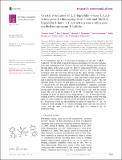Files in this item
Crystal structures of 2,2′-bipyridin-1-ium 1,1,3,3-tetracyano-2-ethoxyprop-2-en-1-ide and bis(2,2′-bipyridin-1-ium) 1,1,3,3-tetracyano-2-(dicyano-methylene) propane-1,3-diide
Item metadata
| dc.contributor.author | Setifi, Z. | |
| dc.contributor.author | Valkonen, A. | |
| dc.contributor.author | Fernandes, M.A. | |
| dc.contributor.author | Nummelin, S. | |
| dc.contributor.author | Boughzala, H. | |
| dc.contributor.author | Setifi, F. | |
| dc.contributor.author | Glidewell, C. | |
| dc.contributor.author | Harrison, W.T.A. | |
| dc.date.accessioned | 2015-05-25T11:40:05Z | |
| dc.date.available | 2015-05-25T11:40:05Z | |
| dc.date.issued | 2015-05 | |
| dc.identifier | 190297089 | |
| dc.identifier | 207d5d3e-8b74-4acc-83ee-2a556f0b7eaf | |
| dc.identifier | 84928137868 | |
| dc.identifier | 000369977900093 | |
| dc.identifier.citation | Setifi , Z , Valkonen , A , Fernandes , M A , Nummelin , S , Boughzala , H , Setifi , F , Glidewell , C & Harrison , W T A 2015 , ' Crystal structures of 2,2′-bipyridin-1-ium 1,1,3,3-tetracyano-2-ethoxyprop-2-en-1-ide and bis(2,2′-bipyridin-1-ium) 1,1,3,3-tetracyano-2-(dicyano-methylene) propane-1,3-diide ' , Acta Crystallographica. Section E, Structure reports online , vol. 71 , no. 5 , pp. 509-515 . https://doi.org/10.1107/S2056989015007306 | en |
| dc.identifier.issn | 1600-5368 | |
| dc.identifier.uri | https://hdl.handle.net/10023/6685 | |
| dc.description.abstract | In 2,2'-bipyridin-1-ium 1,1,3,3-tetracyano-2-ethoxyprop-2-en-1-ide, C10H9N2+·C9H5N4O-, (I), the ethyl group in the anion is disordered over two sets of atomic sites with occupancies 0.634 (9) and 0.366 (9), and the dihedral angle between the ring planes in the cation is 2.11 (7)°. The two independent C(CN)2 groups in the anion make dihedral angles of 10.60 (6) and 12.44 (4)° with the central propenide unit, and the bond distances in the anion provide evidence for extensive electronic delocalization. In bis(2,2'-bipyridin-1-ium) 1,1,3,3-tetracyano-2-(dicyanomethylene)propane-1,3-diide [alternative name bis(2,2'-bipyridin-1-ium) tris(dicyanomethylene)methanediide], 2C10H9N2+·C10N62- (II), the dihedral angles between the ring planes in the two independent cations are 7.7 (2) and 10.92 (17)°. The anion exhibits approximate C3 symmetry, consistent with extensive electronic delocalization, and the three independent C(CN)2 groups make dihedral angles of 23.8 (2), 27.0 (3) and 27.4 (2)° with the central plane. The ions in (I) are linked by an N-HN hydrogen bond and the resulting ion pairs are linked by two independent C-HN hydrogen bonds, forming a ribbon containing alternating R44(18) and R44(26) rings, where both ring types are centrosymmetric. The ions in (II) are linked by two independent N-HN hydrogen bonds and the resulting ion triplets are linked by a C-HN hydrogen bond, forming a C21(7) chain containing anions and only one type of cation, with the other cation linked to the chain by a further C-HN hydrogen bond. | |
| dc.format.extent | 7 | |
| dc.format.extent | 940151 | |
| dc.language.iso | eng | |
| dc.relation.ispartof | Acta Crystallographica. Section E, Structure reports online | en |
| dc.subject | Crystal structure | en |
| dc.subject | Bipyridinium cations | en |
| dc.subject | Polynitrile anions | en |
| dc.subject | Molecular conformation | en |
| dc.subject | Hydrogen bonding | en |
| dc.subject | QD Chemistry | en |
| dc.subject | DAS | en |
| dc.subject.lcc | QD | en |
| dc.title | Crystal structures of 2,2′-bipyridin-1-ium 1,1,3,3-tetracyano-2-ethoxyprop-2-en-1-ide and bis(2,2′-bipyridin-1-ium) 1,1,3,3-tetracyano-2-(dicyano-methylene) propane-1,3-diide | en |
| dc.type | Journal article | en |
| dc.contributor.institution | University of St Andrews. School of Chemistry | en |
| dc.identifier.doi | 10.1107/S2056989015007306 | |
| dc.description.status | Peer reviewed | en |
| dc.identifier.url | http://scripts.iucr.org/cgi-bin/sendsup?hb7404 | en |
This item appears in the following Collection(s)
Items in the St Andrews Research Repository are protected by copyright, with all rights reserved, unless otherwise indicated.

